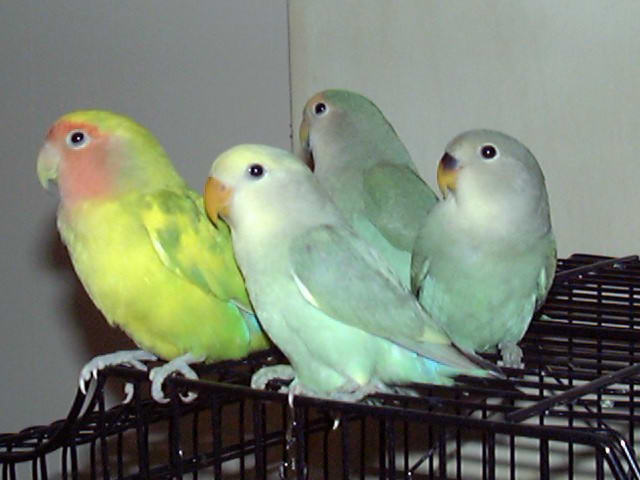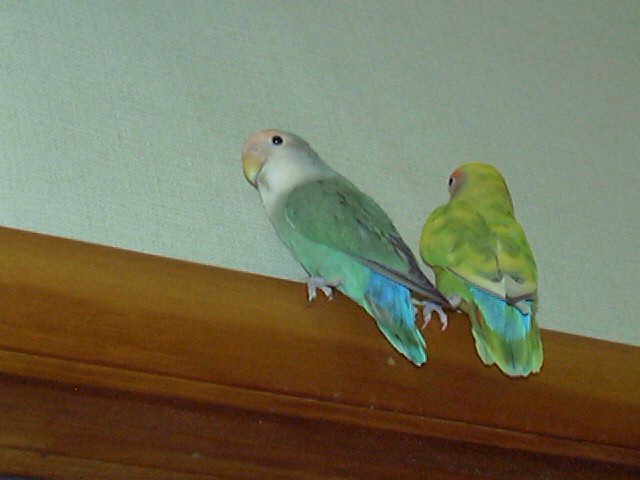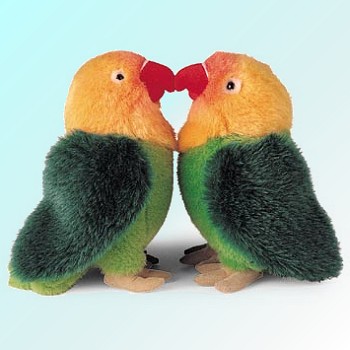Discover Lovebirds
& keeping Lovebirds
as Pets
|
|
Please Help Pets by Donating One Dollar
Lovebirds are playful little parrots that come in
a variety of colors including blue, green and yellow.
Breeding over the years has produced a wide variety
of other colors.
They are high energy birds and need space to climb
and time out of their cage to burn off excess energy.
Lovebirds are not good talkers or cuddlers, but they
can be taught a few basic tricks. Most birds will do
a good bit of chirping
Lovebirds can be kept as single pets, however if doing so,
they will require a lot of emotional and physical attention
from you.
Lovebirds kept in pairs mate for live, it is said, if one
bird dies, the other will too.
Lovebirds like to play with and make nests from strips of
unprinted paper, in fact one of their favorite things to
do is tear up paper.
Facts about Pet Lovebirds
Lovebirds live from 15 to 20 years
They are about 5 to 6" tall
Lovebirds come from Africa and Madagascar.
The most commonly kept type of Lovebird are the: peach face,
Fischers and and the masked.
Minimum cage size is 18"W x 22"L x 18"H
Keep cages away from drafts, open windows and the kitchen.
Lovebirds are sensitive to smoke and strong odors. Cover the
cage at night to prevent drafts.
Have perches of different widths, diameters and textures
to help keep a Lovebird's feet healthy.
What to Feed Pet Lovebirds
Feed a Lovebird 2-3 teaspoons per day per bird of a pellet or
seed-based, fortified small parrot diet everyday.
About 5-10% of a Lovebird's diet should be bite-sized fruits and
veggies like apples, grapes, sweet potatoes, broccoli, spinach,
dandelion, mustard greens and shredded carrots. Offer daily or
every 2-3 days. Petey & Petunia love fresh kale.
Keep a cuttle bone or mineral block in a Lovebird's cage at all times.
Lovebirds should always have access to clean, fresh water.
Don't use tap water. We recommend Steam Distilled water
for it's purity.
All About Cleaning
Bird Cages & Accessories
Petey & some of his "kids"

Signs a Pet Lovebird is Healthy
A curious and active disposition
Clear, bright eyes
Clean, smooth feathers
Eats throughout the day
Normal droppings that are not excessively runny for more than a
couple of days
Signs a Lovebird may be getting sick
Change in droppings in excess of two days
Decreased appetite; weight loss
Decreased activity and grooming behavior
Discharge from nose or mouth; sneezing
Feathers fluffed for prolonged periods of time
Sitting at the bottom of cage
Wheezing or coughing
Petey Bird & Petunia
Petey & Petunia came to us from the local Humane Society.
Their previous owner had kept them in a cage, in a dimly lit hallway
and had never let them out of their cage. When the owner got tired
of having them around, she gave them to the society.
The birds came complete with a very nice cage and toys. We
made a nice donation to the society and immediately took the birds
to a qualified avian vet who pronounced them to be in excellent health.
The birds were ecstatic the first time they were allowed to fly out of
their cage. Now they're spoiled rotten and very well taken care of.
Each bird now knows it's name, but since they came to us at about 5 years
of age and set in their ways, they are not responding very well to
learning tricks.
Petunia laid 4 eggs the first winter we had them. Do to an unfortunate
accident, the nest box was dropped and all eggs ruined. About 2 weeks later
Petunia laid 4 more eggs and hatched them giving us 4 exceptionally
cute babies. Each baby lovebird was given to a good home.
Picture Lovebirds
Petunia is on left, Petey Bird on right
Both are Peachface

Adorable Plush Stuffed Lovebirds

|